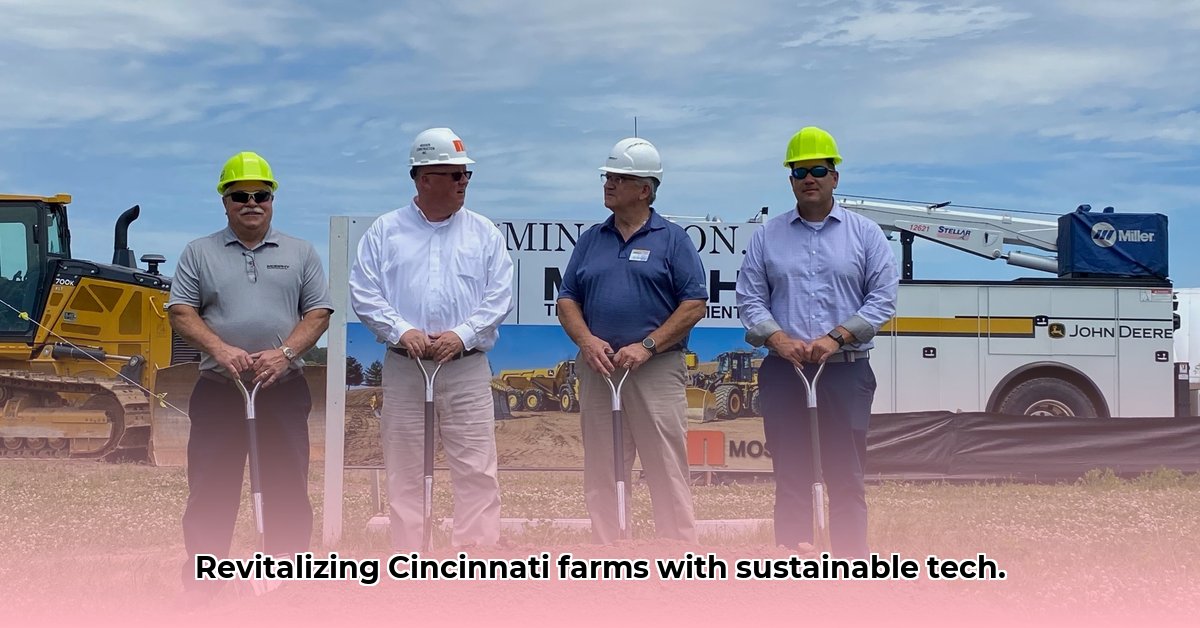
Murphy Tractor Cincinnati Ohio: Revving Up Sustainable Farming in the Queen City
Farming in Cincinnati is evolving, embracing smarter, more efficient, and environmentally friendly practices. Precision agriculture, utilizing technology to optimize farming, is at the forefront of this transformation. This guide explores how Murphy Tractor is aiding Cincinnati farmers in adopting precision agriculture techniques, focusing on real-world examples, challenges, and actionable steps towards building sustainable and profitable farms. For more information on Mahindra tractors, check out this resource.
Boosting Yields and Profits: Smart Farming in Action
Precision agriculture aims for zero waste. Imagine GPS-guided tractors planting seeds with pinpoint accuracy, eliminating over-planting and maximizing seed utilization. Smart soil sensors monitor moisture levels, ensuring irrigation only when and where needed, conserving water and reducing costs. Drones provide aerial views of fields, allowing for early detection of problems like nutrient deficiencies or pest infestations. These technologies, accessible through Murphy Tractor, are not futuristic concepts; they're current tools boosting yields by 5-10% and improving profitability for Cincinnati farmers. Isn't optimizing resource use a compelling reason to explore precision agriculture?
A Greener Approach: Farming Sustainably in Cincinnati
Precision agriculture's benefits extend beyond profitability; it promotes environmental responsibility. Efficient resource management leads to reduced environmental impact. Lower fertilizer and pesticide use translates to cleaner water and healthier soil. Water conservation is particularly vital in Ohio's climate. Studies indicate that precision agriculture practices can decrease chemical use by 15-20%, significantly mitigating environmental impact. Partnering with Murphy Tractor enables Cincinnati farmers to become environmental stewards, contributing to a healthier community.
The Challenges of Modern Farming: Getting Started with Precision Agriculture
Adopting precision agriculture presents challenges, especially for smaller farms. The initial investment can be substantial. Learning to utilize the technology and interpreting the resulting data requires training and time. Furthermore, regulatory uncertainties regarding data privacy and ownership need clarification. However, these obstacles shouldn’t deter farmers from exploring the benefits of precision agriculture.
Overcoming the Obstacles: Working Together for a Sustainable Future
Fortunately, collaborative efforts are making precision agriculture more accessible. Government programs offer financial assistance to offset initial costs. Murphy Tractor and other organizations provide training to build farmer expertise and confidence. Open data platforms facilitate knowledge sharing among farmers. The key is collaboration between farmers, technology providers (like Murphy Tractor), and agricultural researchers.
A Step-by-Step Guide to Precision Farming with Murphy Tractor
This plan offers a practical approach for Cincinnati farmers:
- Assess Your Needs: Identify areas where precision agriculture can maximize efficiency and resource savings.
- Explore Funding Options: Research available government grants, loans, and subsidies through Murphy Tractor's support.
- Invest in Training: Participate in workshops and training sessions offered by Murphy Tractor and local agricultural organizations.
- Start Small, Think Big: Implement one or two technologies initially, gradually expanding as expertise grows.
- Track Your Progress: Monitor progress using data generated by the technologies and fine-tune strategies accordingly.
The Future of Cincinnati Farming: A Bright Outlook
Cincinnati farming has a promising future. By embracing precision agriculture and collaborating with partners like Murphy Tractor, farmers can create more efficient, profitable, and sustainable operations. This contributes to a vibrant agricultural community and a healthier environment. The potential for growth within Cincinnati's agricultural sector is substantial.
How to Overcome Data Interoperability Challenges in Precision Agriculture
Key Takeaways:
- Seamless data flow is crucial for precision agriculture's success. Integrating diverse data sources is essential for optimization.
- Data silos hinder progress. Standardized data formats are vital for efficient system operation.
- Farmers need accessible tools and training. Intuitive interfaces are necessary for widespread technology adoption.
- Collaboration is key; partnerships between farmers, technology providers, and government agencies are vital.
- Sustainable farming benefits from integrated data analysis, transforming data into actionable insights for better decision-making.
The Data Deluge: A Farmer's Dilemma
Cincinnati farmers often face the challenge of managing vast amounts of data from various sources. Soil sensor data, weather forecasts, yield maps, and tractor GPS information create a data overload. This data deluge can hinder effective analysis and informed decision-making which is critical for efficient resource use and profitability. Addressing the interoperability challenges is essential for unlocking the full potential of precision agriculture.
Breaking Down Data Silos: The Need for Standards
The major hurdle is data silos—different systems using incompatible formats. This is like trying to assemble a complex machine with parts that don’t fit. Establishing standardized data formats is crucial for seamless communication between different systems. This enables a unified, efficient data flow for better analysis and decision-making.
Bridging the Gap: Actionable Insights
Integrated data analysis transforms raw data into actionable information. A centralized dashboard displaying all farm data allows farmers to precisely target fertilizer applications, optimize irrigation, and identify areas with low yields, ultimately improving efficiency and sustainability. This is a significant step toward achieving sustainable farming practices.
Empowering Farmers: Technology and Training
User-friendly software and comprehensive training are essential components of successful technology adoption. Intuitive interfaces and thorough training programs empower farmers to effectively use technology, unlocking data-driven insights for improved decision-making. This is crucial for ensuring the widespread adoption of precision agriculture.
Partnerships for Success: Collaboration is Crucial
Addressing data interoperability challenges requires collaborative efforts. Government agencies can support research, establish standards, and provide training. Technology providers must develop user-friendly software and ensure seamless data integration. Farmers need to actively participate in shaping solutions. It is through strong partnerships that we can unlock the true power of precision agriculture.
A Sustainable Future: Precision Agriculture's Promise
By overcoming the challenges of data interoperability, including standardization, user-friendly interfaces, and collaboration, the full potential of precision agriculture will be realized. Farmers will be better equipped to make data-driven decisions, improve resource efficiency, and promote environmentally sustainable practices, leading to a more resilient and prosperous agricultural future.